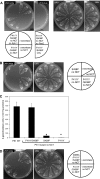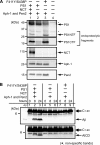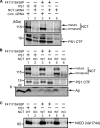Nicastrin is dispensable for gamma-secretase protease activity in the presence of specific presenilin mutations
- PMID: 19254953
- PMCID: PMC2676034
- DOI: 10.1074/jbc.M807653200
Nicastrin is dispensable for gamma-secretase protease activity in the presence of specific presenilin mutations
Abstract
gamma-Secretase is a multisubunit membrane protein complex consisting of presenilin (PS1), nicastrin (NCT), anterior pharynx-1, and presenilin enhancer 2. To analyze the activity of familial Alzheimer disease mutants and to understand the roles of the subunits, we established a yeast transcriptional activator Gal4p system with artificial gamma-secretase substrates containing amyloid precursor protein or Notch fragments. The gamma-secretase activities were evaluated by transcriptional activation of reporter genes upon Gal4p release from the membrane-bound substrates, i.e. growth of yeast on histidine and adenine, or beta-galactosidase assay. We screened and evaluated gamma-secretase mutants using this reconstitution system in yeast, which does not possess endogenous gamma-secretase activity. When we introduced familial Alzheimer mutants of PS1 in this system, their activities were shown to be loss of function. Although the protease activity of wild type PS1 depends on the other three subunits introduced, we obtained 15 new PS1 mutants, which are active in the absence of NCT. They possessed a S438P mutation at the ninth transmembrane domain (TM9) together with one missense mutation distributed through transmembrane and loop regions. These mutations were not related to familial Alzheimer mutations of PS1 as identified so far. The S438P mutant was partially active but required other mutations for full activation. Results of the beta-galactosidase assay suggested that they have wild type protease activities, which were further confirmed by the endoproteolysis of PS1, amyloid beta peptides, and Notch intracellular domain production in mammalian cells. These results suggest that NCT is dispensable for the protease activity of gamma-secretase.
Figures






Similar articles
-
Advanced Yeast Models of Familial Alzheimer Disease Expressing FAD-Linked Presenilin to Screen Mutations and γ-Secretase Modulators.Methods Mol Biol. 2019;2049:403-417. doi: 10.1007/978-1-4939-9736-7_23. Methods Mol Biol. 2019. PMID: 31602624
-
Suppressor Mutations for Presenilin 1 Familial Alzheimer Disease Mutants Modulate γ-Secretase Activities.J Biol Chem. 2016 Jan 1;291(1):435-46. doi: 10.1074/jbc.M114.629287. Epub 2015 Nov 11. J Biol Chem. 2016. PMID: 26559975 Free PMC article.
-
A presenilin-1 mutation identified in familial Alzheimer disease with cotton wool plaques causes a nearly complete loss of gamma-secretase activity.J Biol Chem. 2010 Jul 16;285(29):22350-9. doi: 10.1074/jbc.M110.116962. Epub 2010 May 11. J Biol Chem. 2010. PMID: 20460383 Free PMC article.
-
Genes and mechanisms involved in beta-amyloid generation and Alzheimer's disease.Eur Arch Psychiatry Clin Neurosci. 1999;249(6):266-70. doi: 10.1007/s004060050098. Eur Arch Psychiatry Clin Neurosci. 1999. PMID: 10653281 Review.
-
The catalytic core of gamma-secretase: presenilin revisited.Curr Alzheimer Res. 2008 Apr;5(2):147-57. doi: 10.2174/156720508783954677. Curr Alzheimer Res. 2008. PMID: 18393799 Review.
Cited by
-
Cellular mechanisms of γ-secretase substrate selection, processing and toxicity.Prog Neurobiol. 2012 Aug;98(2):166-75. doi: 10.1016/j.pneurobio.2012.05.006. Epub 2012 May 20. Prog Neurobiol. 2012. PMID: 22622135 Free PMC article. Review.
-
Notch signaling without the APH-2/nicastrin subunit of gamma secretase in Caenorhabditis elegans germline stem cells.Genetics. 2024 Jul 8;227(3):iyae076. doi: 10.1093/genetics/iyae076. Genetics. 2024. PMID: 38717968 Free PMC article.
-
Specific Mutations near the Amyloid Precursor Protein Cleavage Site Increase γ-Secretase Sensitivity and Modulate Amyloid-β Production.Int J Mol Sci. 2023 Feb 16;24(4):3970. doi: 10.3390/ijms24043970. Int J Mol Sci. 2023. PMID: 36835396 Free PMC article.
-
Deletion-based mechanisms of Notch1 activation in T-ALL: key roles for RAG recombinase and a conserved internal translational start site in Notch1.Blood. 2010 Dec 16;116(25):5455-64. doi: 10.1182/blood-2010-05-286328. Epub 2010 Sep 17. Blood. 2010. PMID: 20852131 Free PMC article.
-
Mutation analysis of the presenilin 1 N-terminal domain reveals a broad spectrum of gamma-secretase activity toward amyloid precursor protein and other substrates.J Biol Chem. 2010 Dec 3;285(49):38042-52. doi: 10.1074/jbc.M110.132613. Epub 2010 Oct 4. J Biol Chem. 2010. PMID: 20921220 Free PMC article.
References
-
- Selkoe, D. J. (2001) Physiol. Rev. 81 741-766 - PubMed
-
- Edbauer, D., Winkler, E., Regula, J. T., Pesold, B., Steiner, H., and Haass, C. (2003) Nat. Cell Biol. 5 486-488 - PubMed
-
- Laudon, H., Hansson, E. M., Melén, K., Bergman, A., Farmery, M. R., Winblad, B., Lendahl, U., von Heijne, G., and Näslund, J. (2005) J. Biol. Chem. 280 35352-35360 - PubMed
-
- Oh, Y. S., and Turner, R. J. (2005) Biochemistry 44 11821-11828 - PubMed
-
- Spasic, D., Tolia, A., Dillen, K., Baert, V., De Strooper, B., Vrijens, S., and Annaert, W. (2006) J. Biol. Chem. 281 26569-26577 - PubMed
Publication types
MeSH terms
Substances
LinkOut - more resources
Full Text Sources
Other Literature Sources
Medical

